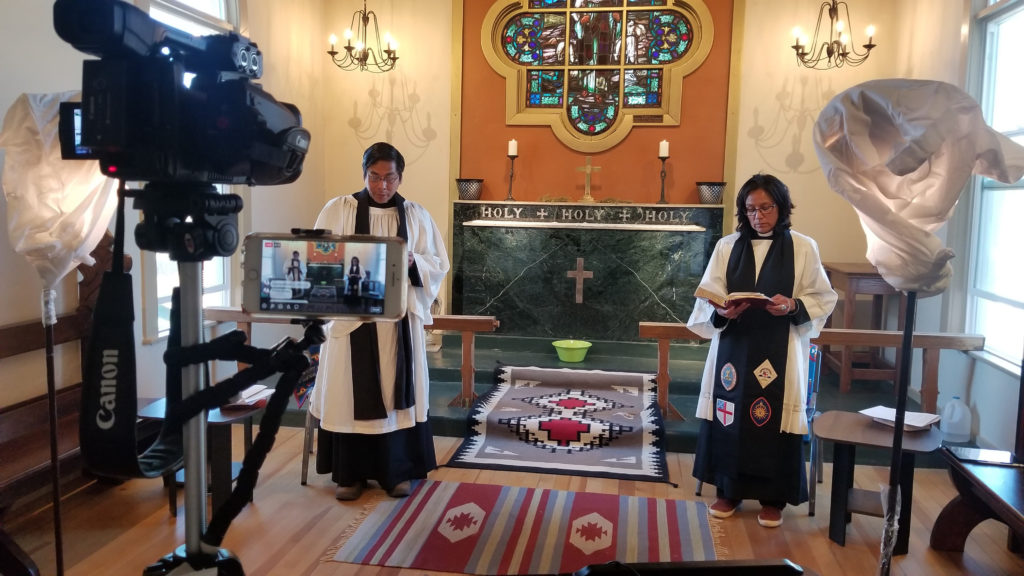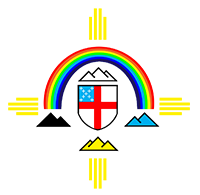
Clergy at a church in Navajoland offer an online service during the pandemic. Photo: Navajoland
 When the COVID-19 pandemic derailed a planned pilgrimage to Navajoland for a St. Clement by-the-Sea youth group, the San Clemente congregation shifted gears, and sparked a fundraising campaign, resulting in $15,000 in aid for the hard-hit Navajo Nation.
When the COVID-19 pandemic derailed a planned pilgrimage to Navajoland for a St. Clement by-the-Sea youth group, the San Clemente congregation shifted gears, and sparked a fundraising campaign, resulting in $15,000 in aid for the hard-hit Navajo Nation.
Navajoland includes portions of the Navajo Reservation, and the Episcopal Dioceses of Utah, New Mexico and Arizona. Roughly the size of West Virginia, at 27,000 square miles of high plains and desert, it is the largest reservation of its kind. Historic inequities, including a 40% unemployment rate, have made its 173,000 residents especially vulnerable to the coronavirus. Nearly 40% of residents live below the poverty line, earning less than $12,760 a year.
As of July 28, 2020, there were a confirmed 8,927 coronavirus cases and 446 reported COVID-19 related deaths, and Navajoland Bishop David E. Bailey said the numbers continue to rise.
“The diocese is continuing to provide food and hygiene products and water to about 300 families, not necessarily Episcopalians, as we see the need, including those that have tested positive,” he said.
“Our folks are going out and leaving a box of food where people can get to it, without exposing themselves. We don’t anticipate it getting any better for a while. This is a long-term thing for us, especially because a number of our people are elderly or immune-compromised because of diabetes.”
A 2014 study found that in the Navajo Nation one in five adults has diabetes; an estimated 75,000 have prediabetes. Approximately 75% of households experience some level of food insecurity, unable to get enough food because of lack of money or access to supplies.
Bailey said he is overwhelmed by the outpouring of love and support from across the Episcopal Church and especially by the San Clemente youth group and those they inspired.

St. Clement’s Church, San Clemente
The Rev. Patrick Crerar, St. Clement’s rector, said ideas for the fundraiser evolved after plans for a 2020 youth pilgrimage had to be postponed until 2021 because of the coronavirus pandemic.
The San Clemente church’s youth group had hoped “to meet with Navajo storytellers, visit their sacred sites, and probably help in an outreach-like experience (such as helping rebuild a school or playground). This … would be about forming relationships, learning about Native American history (especially Navajo history) and attempting to heal wounds so that we might all have a better, more connected future.”
Enthusiasm grew among the youth and the congregation. “One of our parishioners with a degree in Native American studies began covering some of that history with our youth,” Crerar told The Episcopal News in a recent email. “We also began to explore theological questions, like can a canyon be as holy a place as a cathedral?”
But, as the fundraising and plans for the trip progressed, coronavirus arrived.
Although the youth were disappointed, “We also wanted to be a help, a blessing to those we had intended to visit with in person,” Crerar said. “We began contemplating what we could do.”
Crerar also consulted with colleagues in other local congregations, and the city’s Church of Jesus Christ of Latter-Day Saints ward offered a $10,000 grant.
“This inspired us,” Crerar recalled. St. Clement’s raised $5,000 and sent it and the LDS grant to Bailey, who said the money is both welcomed and much needed.
“I don’t anticipate it getting any better for a while,” Bailey told The News. “There are only 13 grocery stores on the Navajo Reservation, and they have been closed. A lot are convenience markets that have processed food. We are trying to make sure people are receiving fresh food and meats.
“One-third of the reservation has no running water in their homes and no electricity. As we do our food distribution, we have to be sensitive about who we’re giving it to, if there is refrigeration space in homes.”
He said that food collections and in-kind donations are not as helpful because “Folks donate but then we have to pay for the trucking costs.” Receiving cash donations makes it easier to access food and water for residents, he said.
As the pandemic stretches out, he is concerned about the coming fall and winter seasons. “We will be trying to provide heating for people who don’t have jobs and who can’t afford propane or coal or wood. This pandemic is not going anyway any time soon.”
Bailey said in a letter posted on the Navajoland diocesan website that inpatient intensive care unit space is limited in the three local major hospitals, with many people having to go 20 or more miles for doctors or food.
The church continues to provide worship opportunities on Facebook and its website, as well as packets for home worship and daily meditation and prayer.
“The challenges for ministry are great, but we’re responding with love and care,” he wrote to the Diné (“The People”), the indigenous Navajo. “What makes the challenge more difficult is our loss of income because of isolation.
“Normally, we would be experiencing visitations, partners, and winter/spring visitors who help us meet our financial needs. But, with the reservation closed and people not able to travel, the financial impact for us is huge.”
The diocese continues to aid residents with such immediate needs as heat, food, water, shelter, pastoral care and ongoing ministries. To assist, visit the Navajoland website here.
